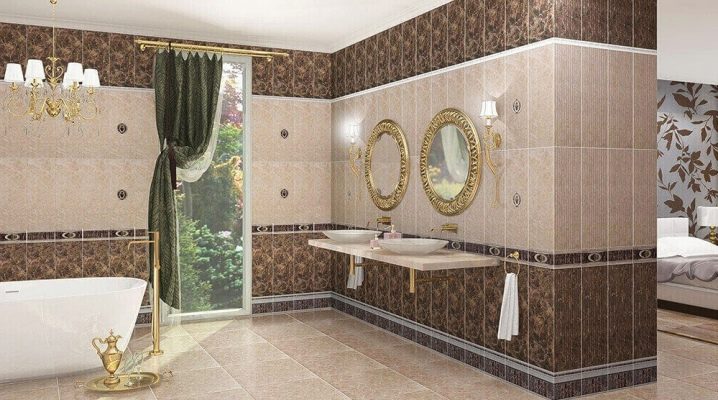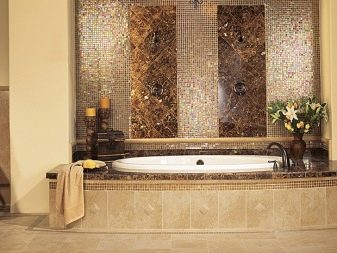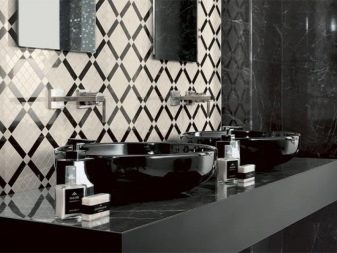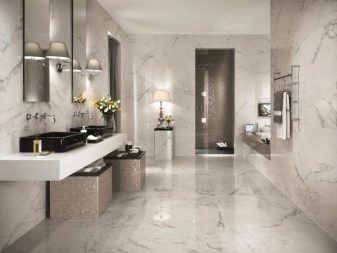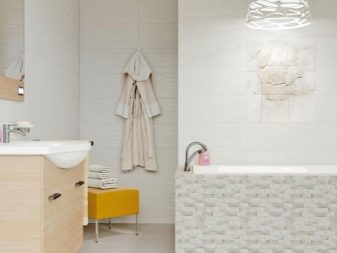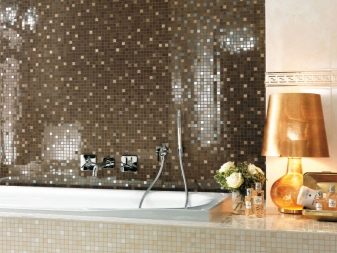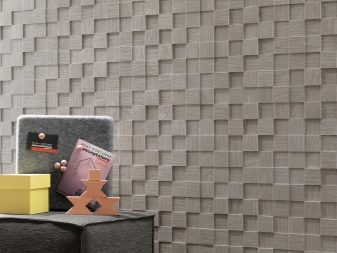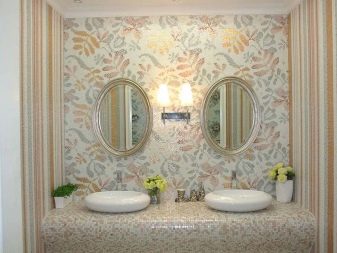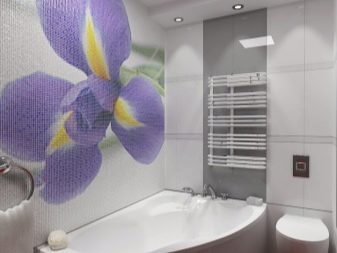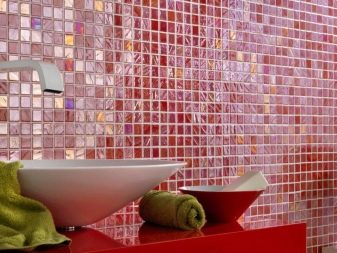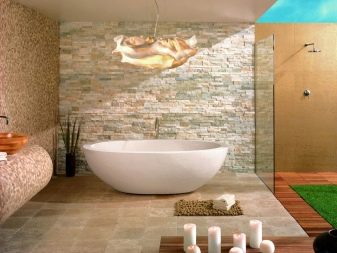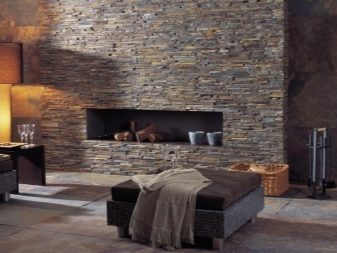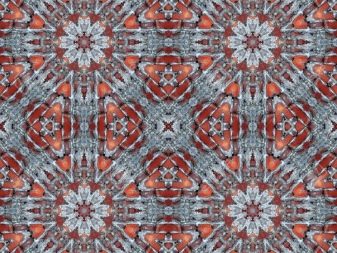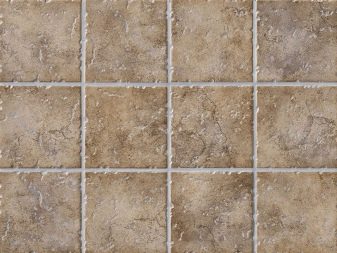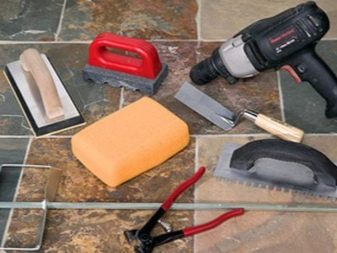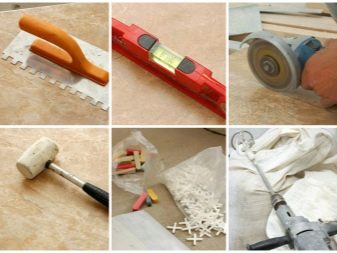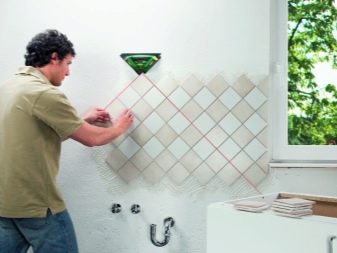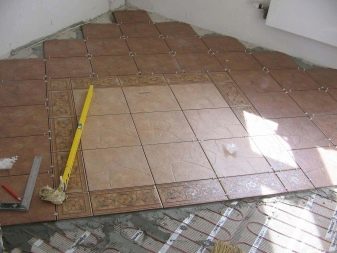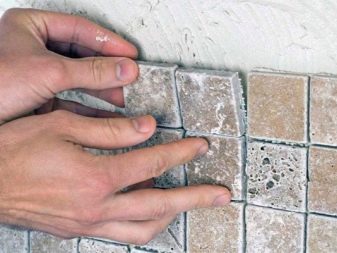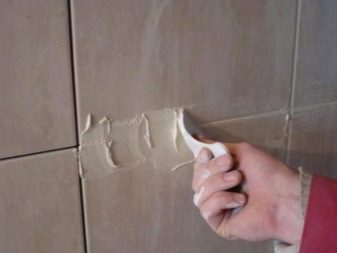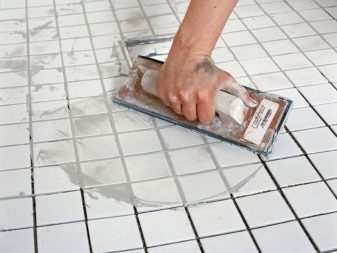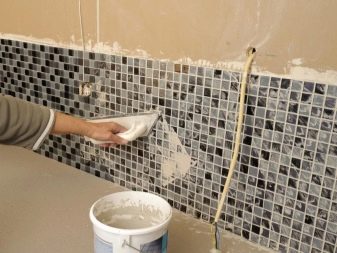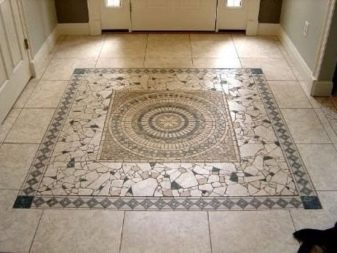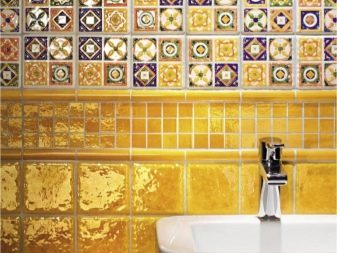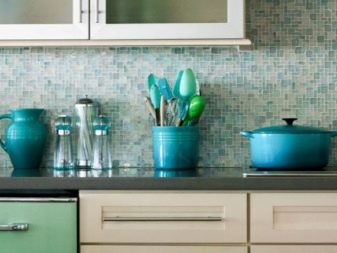Mosaic of porcelain tiles in the interior
Ceramic granite mosaic is a very popular material for interior decoration. It is used in various types of premises and always brings originality and beauty to the atmosphere. Modern building stores offer many varieties of tiles from this material. Therefore, it is important to familiarize yourself in advance with all the features of porcelain stoneware and the nuances of its use.
Advantages and disadvantages
Among all the characteristics of ceramic granite mosaic, you can find both positive and negative qualities of the material.
We highlight the main advantages of porcelain products.
- Environmental friendliness. Material of natural origin does not harm health. It does not contain harmful components and is completely safe for use.
- Resistance to moisture.Such coatings do not absorb liquid, and do not deteriorate upon contact with water.
- Mosaic porcelain has a high strength. Material withstands mechanical effects.
- Mosaic can withstand temperature changes. With different climatic changes, the tile does not lose its presentable appearance.
An important advantage is the originality of the coating. Compared to standard tiles, this veneer looks unusual. It often becomes an accent in the interior of various rooms.
- Mosaic often helps in zoning rooms. Thanks to this technique specific areas of the room are distinguished.
- Mosaic porcelain stoneware helps to create an exclusive design. With the help of such tiles on the surfaces are laid out drawings on individual projects.
- The material is suitable for surfaces of various shapes. With this coating you can arrange not only a flat plane, but also convex-concave surfaces.
- The similar tile is capable to mask all errors of a basis. Small details, located close to each other, perfectly conceal flaws,and with the help of the game of color, you can hide flaws on both horizontal and vertical surfaces.
- A wide selection of indicators of abrasion. The range of tiles is suitable for both walls and floor. As a floor covering, which often has a high permeability, a material with indicators from 2 to 5 is used. For walls, you can choose a material that is slightly less prone to abrasion.
- The coating is not slippery. Despite the fact that most models of mosaic porcelain stoneware are available in glossy variations, this material does not slip due to the presence of seams often located between the details of the mosaic. Grout filling them improves adhesion to the surface.
- The material is somewhat universal. It is suitable for finishing both residential and public facilities, in the list of which pools, monuments, metro stations and public places with a large crowd of people are included.
In addition to the positive qualities, several negative characteristics are also inherent in porcelain stoneware.
- First of all, users focus on the complexity of installation. Such a coating, as a rule, is applied for a very long time, especially if users do not have experience in carrying out such a lining.Accordingly, there is a need for additional costs for the services of professional tilers.
- The price of some products is very high compared to the prices of other types of materials. But remember that even the high cost of mosaic from some firms is justified by the high quality and numerous other advantages of the material.
Kinds
In order not to get lost in the diversity of porcelain stoneware products, it is necessary to get acquainted in advance with various ways of classifying such products.
The first attribute refers to the surface texture. These types of texture are distinguished:
- Glazed models have a glossy texture and are perfect for rooms with high humidity, such as a bathroom and a swimming pool.
- In other rooms, unglazed mosaic is used, which gives additional comfort to the rooms.
- Satined mosaic does not have a pronounced brilliance in its texture, but this coating is almost devoid of slipperiness.
- Structured mosaic is used as an exclusive cover. It is usually a combination of several textures.Such products include vintage mosaic varieties, on the surface of which cracks, chips and other traces of mechanical effects are specially made.
- To create the effect of volumetric coverage, designers use a relief type of ceramic granite tile. Such an unusual appearance can optically change the area of a room.
An important feature of product classification is the design feature of each product.
- Ceramic products under the mosaic, the method of laying which is similar to the laying of ordinary tiled models. Such material is suitable only for finishing smooth surfaces.
- Sometimes, as a fastening of mosaic elements, a grid is used, which is a special frame made of paper or other materials. Every square of the tile is fixed on it, and all the elements at the expense of the grid represent one whole.
- To create particularly complex compositions, the elements of the panel are laid out singly. Such work is more labor-intensive, but with the use of such technology, real masterpieces can be obtained.
When dividing porcelain stoneware into varieties, it is necessary to take into account such criteria as material.
Various components are used as raw materials.
- Plastic - one of the newest varieties of tiles. Often, elements from such recycled materials act as an important and original component of mosaic structures.
- GlassThermally treated is very popular for creating unusual coatings. In addition, this material is very resistant to various kinds of influences, including various chemicals and alkalis.
- A natural stone looks very stylish and soundly. In addition, it is very durable, and due to this often such a lining can be seen as floor coverings.
- In rooms with low humidity levels, mosaic structures can be inserted metallic sections. Such elements often have an accent role.
- Ceramics - a very interesting type of material, which is presented in different variations as a component of a mosaic panel. In addition, such material can be purchased at a reasonable price.
According to the features of color design, there are several types of ceramic granite mosaic.
- Monophonic - glazed products, each element of which is uniformly painted in one color.
- Patterned surfaces suggest the presence of a specific pattern on each part, but they look most advantageous in combination with monochromatic models.
- For matte mosaic, gradient coloring is common, which is a smooth transition from one tone to another. Such a design can be embodied in a different combination of shades.
- Porcelain stoneware mosaic products can imitate natural materials such as stone or wood. The surface of the tile looks very unusual and is suitable for many styles in which the emphasis is placed on the use of natural materials.
Piling
The process of self-lining the surface is not as difficult as it may seem at first glance.
To implement it, you need to stock up on the necessary number of tools and materials.
- Spatulas of three types: notched, rubber and smooth;
- Grout. This component is selected based on the color of the coating. Some people prefer to make seams in contrast to the tone of the mosaic, but in most cases they use a similar color. Epoxy resins should be the basis for the grouting material, because the standard cement substance contains sand that can damage the material;
Polyurethane, silicone or two-component adhesive composition can be selected as a component for bonding.
Preparatory stage
An important procedure is to prepare the base for mosaic coating. The whole point of surface treatment is aimed at increasing the subsequent adhesion of porcelain stoneware to the base.
First of all, you should get rid of various chips and cracks, giving the base surface an evenness.
It is important not to overdo it, because if the surface is too smooth, the level of adhesion will decrease. It is best to sandblast the base. Make sure that there are no traces of grease, rust and other contaminants on the walls or the floor, as they can significantly disrupt the function of the adhesive. After you need to carefully primed surface.
Main stage
If you are installing the finished modules, it is necessary to make the layout of the base.
- Next, you need to prepare the glue, based on the instructions, which, as a rule, is on the packaging of the composition. It is best to prepare the solution in parts, because it quickly freezes.
- Using a smooth spatula, glue is applied to the surface.They should not immediately cover a large area, the maximum allowable is 9 sheets.
- After the glue is leveled with a notched trowel.
- The porcelain stoneware element is pressed against the adhesive composition, it must also be smoothed using a rubber spatula. If you are using a product with a mesh base, the mesh should sink slightly into the glue.
- Pay attention to the width of the seams. If you are using modular masonry, then all seams should have the same thickness. But if you carry out the facing, applying each element separately, then the difference in the thickness of the joints is permissible according to the features of the drawing.
- After three days, remove excess glue with a cotton wool soaked in ethyl alcohol.
- After that, grouting is carried out, during which a fugue is applied with a rubber spatula, the excess is immediately removed with a cloth dampened with water. After the grout finally hardens, the mosaic is rubbed with a dry cloth.
Examples in the interior
- A special type of art that is used for interior design is the creation of a pattern on the surface of ceramic granite tiles. Alternating in a special way, mosaic components can create a whole panel.
- In some interior styles, a combination of matte and glossy elements is permissible when creating mosaic flooring.
- With the help of mosaic porcelain, you can effectively decorate an element such as an apron in the kitchen.
See the mosaic in interior design below.
